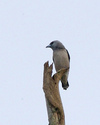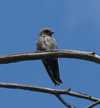Genus Artamus
Dusky Woodswallow - The name "woodswallow" is a misnomer as they are not closely related to true swallows. Instead, they belong to the family Artamidae, which also includes butcherbirds, currawongs and the Australian Magpie.
Ashy Woodswallow - The plumage of this species is pale grey.
Bismarck Woodswallow - Its natural habitat is subtropical or tropical moist lowland forests.
White-breasted Woodswallow - The species was first described by Linnaeus in 1771, its specific epithet derived from the Ancient Greek words leucos 'white', and rhynchos 'bill'.
Fiji Woodswallow - The Fiji Woodswallow is a species of woodswallow in the family Artamidae. It is endemic to most of the islands of Fiji, although it is absent from Kadavu and the Lau Archipelago.
Little Woodswallow - As its name suggests, at 12 to 14 cm in length it is the smallest of the woodswallows. It is dark, smoky brown overall, with deep gunmetal grey wings and a black-tipped, blue-tinged bill.
Ivory-backed Woodswallow - Its natural habitats are subtropical or tropical moist lowland forests and subtropical or tropical moist montanes.
White-browed Woodswallow - White-browed Woodswallows are highly nomadic. Pairs, small parties, and sometimes flocks of thousands wander irregularly around inland Australia, often trending north to winter in the Northern Territory and central Queensland, and south in spring to nest. Their heartland is the area centered on the Murray-Darling Basin, but they range far beyond this area, and in drought years frequently reach coastal south-east Australia. They are uncommon in Western Australia but small numbers regularly associate with flocks of the Masked Woodswallows.




